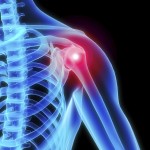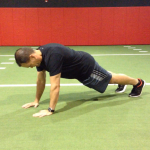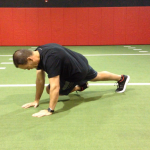Brian Schiff’s Blog
Injury Prevention, Sports Rehab & Performance Training Expert
Do you suffer with shoulder instability, shoulder weakness, poor trunk control or chronic shoulder/back pain? One of the biggest issues overhead athletes have is poor proximal stability, often leading to scapular dyskinesia. In turn, undue strain and force can cause stress on the rotator cuff and/or labrum.
In addition, nagging back pain can also occur as a result of repetitive micro-trauma. Improving pillar stability can reduce stress with hyperextension and rotation that creates stress and injuries in the lumbar spine.
This exercise is a unique and challenging way to improve shoulder and torso stability. In some instances, the stress on the wrist can be difficult, and in these cases I suggest using a closed fist on the stationary arm or moving to the knees. It is particularly effective exercise for swimmers, gymnasts, overhead athletes, and anyone with a history of shoulder instability.
This exercise is intended for advanced users who want or need to increase shoulder, core and hip stability, while also seeking to improve hip disassociation. The core must function in an anti-extension and anti-rotation fashion throughout which is a safe and effective way to target those muscles while also providing a demanding strengthening exercise for the upper body and hips.
With that said, sufficient upper body strength is a must for this exercise. Clients with wrist pain/weakness or elbow and shoulder pathology should only perform this exercise provided they have are symptom free and have moved through the following progressions. In many cases, it is best to start with tall planking and leg lift progressions on the floor before trying this exercise.
The video below will review the exercise in one of my latest columns for PFP Magazine.
Many of my clients need to improve shoulder and pillar stability. Combating poor glenohumeral and scapular stability and insufficient trunk stability is a must to reduce injury risk, resolve shoulder and back pain and eliminate compensatory motion with exercise, sport and life.
The following two exercises are “go to” ones I utilize to do just this.
The links above are for two recent exercise columns I authored for PFP Magazine. These exercises include load bearing using the client’s bodyweight and include progressions and regressions.
Increasing shoulder, torso and hip strength and stability is a common training goal for athletes involved in sport. Facilitating hip disassociation and kinetic chain linking with exercise is always a plus. I like to use a diagonal mountain climber with hip extension to accomplish these objectives. More specifically, I utilize this exercise with my overhead athletes and anyone involved in cutting, pivoting and rotational sports.
Begin in a tall plank position. The hands should be beneath the shoulders with the feet on the floor and shoulder width apart. Slowly bring the left knee/hip under the body and toward the right elbow. Pause at the end point prior to losing form or control.
Next, return the left leg toward the start position and up into full hip extension in one continuous movement. Pause at the top end of available hip extension and repeat the cycle for 10 repetitions or time on the same leg. Alternate legs and perform 2-3 sets on each side.
Sufficient upper body strength and core/hip stability in a 3 point position is necessary to perform the exercise correctly. At no time should the foot of the moving leg touch the floor or be used to balance the body. As far as a pace, I feel using a 1/1/1/1 cadence works best.
This exercise is an excellent way to promote shoulder, core and hip stability while facilitating hip disassociation as well. Driving the hip back up into extension will activate the gluteals and simultaneously force the stable (fixed) hip to stabilize the pelvis and counterbalance the movement pattern. In addition, the client will have to effectively activate the hip and abdominal musculature throughout to avoid unwanted pelvic tilt/rotation during the movement.
Click here to view the full video of this exercise I did for my ‘Functionally Fit’ column for PFP Magazine.
I readily admit I have had an aversion to abdominal exercises that involve straight leg lowering since my days in pee wee football where we were forced to do lifts and holds a few inches above the ground. Some will relate to a modern day version of this exercise known as “six inches.”
As someone with tight hip flexors and who has personally suffered from sciatica in the past, I am NOT a fan of abdominal training that exposes the lumbar spine to large loads and undue risk related to exercises that involve long levers (e.g. throw downs, scissors, etc) and place high shear force on the spine.
I was reminded of why I feel this way in a fitness class this past week. I take a cycle/core class at my local gym and have done a traditional spinning class twice per week for 3 years. After 45 minutes of cycle, we move to a fitness room for core. I have done this new format for three weeks. This week we were asked to do a series of exercises which included “banana rolls.” If you are unfamiliar with this move, check out You Tube for some video demos.
While this exercise may be effective for core strengthening, I can honestly say as one who has never done the move before that trying to execute it as part of a continuous sequence of movements without rest between the moves was very hard to do with proper form. The fatigued state encouraged using momentum and straining to simply get the movement done (not to mention the fact my greater trochanter was sore from the rolling on the hard aerobic floor).
The next day I woke up with low back pain. My back has not hurt like that in years. In light of the role the iliopsoas plays by virtue of its attachment on the lumbar spine, we must consider the impact of reverse muscle action and how it creates shear on the lumbar spine during movements that rely on stabilization with the legs extended against gravity. Additionally, for those clients like me with muscle tightness, increased lumbar lordosis and a history of low back disorders, health and fitness professionals must consistently evaluate safety and efficacy as well as trying to challenge clientele in a workout session.
For all of these reasons, I increasingly rely on neutral spine anti-extension and anti-rotation training exercises in my programming for athletes and clients of all ages and abilities. That is not to say I never do rotational or active movements. They are appropriate given the right order, progression and demands of the respective individual. I just think we must consider form and risk versus reward in exercise programming.
The exercise video below illustrates how to use sliders in a tall plank position to accomplish great core activation and hip/shoulder stability without stressing the lumbar spine with long lever movements. Keep in mind that quality should override quantity in terms of deciding repetition schemes. Do not let the desire to fatigue clients cause form to suffer as this may increase injury risk.
For more specifics on the execution and progression/regression of this particular exercise, click the link below to read my most recent exercise column for PFP Magazine.
Suffice it to say I will not be doing banana rolls again. While I am not completely discarding the exercise, I do think it should be done in a non-fatigued state and taught incrementally if done at all. Most importantly, we as fitness professionals must always remember to program exercises based on fatigue and skill level, while carefully weighing risk versus reward in group or individual sessions.






